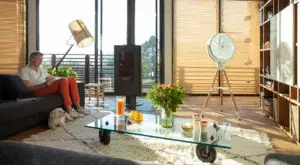Summer often brings with it a wave of heat that makes everyday life at home uncomfortable.
In the face of this, air conditioning, although commonly used, can be an expensive and environmentally unfriendly option. Fortunately, there are greener, more economical alternatives, such as fans.
However, not all fans are created equal. Indeed, while some can be noisy, inefficient or unattractive, other models stand out for their silence, efficiency and design. Among them, the Williwaw fan stands out as a new product developed to beautify our daily lives.
Designed for year-round use, the Williwaw has been tested in various locations around the world, and offers the possibility of adjusting the temperature of your space to your desires. Much more energy-efficient than an air conditioner, this eco-friendly fan provides a light, silent and refreshing breeze, while preserving the environment with a carbon footprint nearly 700 times lower than that of an air conditioner.
But how does this revolutionary fan work? Can it really lower a room’s temperature? What are the best practices for maximizing its efficiency? And how does it differ from a traditional air-conditioning system? This article will answer these questions, while guiding you on how to use a Williwaw fan effectively to stay cool.

The Williwaw is an exceptional fan, recognized as the most powerful on the market, designed with an aesthetic, ecological and functional approach.
Imagined by Stéphane Thirouin, a French designer with a passion for thermal well-being and respect for the environment, it takes its name from a Native American word meaning a cold, powerful wind. Its elegant design makes it a beautiful object to behold, fitting perfectly into the current state of modern interiors.
This fan stands out for its exceptional versatility, adapting perfectly to the needs of each season. Thanks to its pivoting head, it can switch from cooling mode in summer to warm air circulation mode in winter, significantly reducing energy consumption.
What’s more, the Williwaw is a model of intelligent technology. Controllable via a dedicated app, it offers advanced features such as a thermostat, timer and even a convection function, automatically adjusting to room temperature thanks to its state-of-the-art temperature sensors.
Durable and built to last, the Williwaw is made from top-quality materials such as steel, wood and polycarbonate, and is designed to be easily repairable, thus enhancing its longevity. With a 10-year warranty on mechanical parts and a 2-year warranty on electronic components, it’s a smart choice for the long term.

The short answer to this question is no. A fan doesn’t lower the air temperature in a room; it simply circulates the air.
In doing so, it doesn’t change the air temperature, but generates a flow that promotes the evaporation of sweat on our skin, creating a sensation of freshness.
In fact, the use of a fan can lead to a slight rise in ambient temperature due to the heat emitted by its motor, a consequence of its electricity consumption. For this reason, it’s advisable to switch it off when not in use, to avoid wasting energy and unnecessarily raising the temperature.
It’s important to understand that a fan is not an air-conditioning system. It is not designed to effectively reduce air temperature. Rather, its role is to create an artificial wind that can improve comfort in a room to some degree.
To maximize its effectiveness, we recommend positioning it so as to encourage optimum air movement across the room. In addition, you can use tricks such as placing ice in front of it or moistening fabrics to intensify the sensation of freshness.

It’s true that a fan can’t lower the temperature in a room, but it can improve your comfort by generating a pleasant breeze. To get the most out of this appliance, here are a few simple and inexpensive tips, keeping in mind that using a fan doesn’t cost you a lot of money on your electricity bill:
By following these tips, you can improve your well-being with a fan, even without an air conditioner. However, don’t forget to turn the unit off when you’re not in the room, to save energy and avoid heating up your space unnecessarily.

The strategic location of your fan is crucial to maximizing its cooling effect. It’s not simply a matter of placing it at random in the center of the room. The configuration of the space, the presence of heat sources and the direction of air flow must all be taken into account. Here are a few recommendations for positioning your fan effectively:
Following these tips will enable you to make the most of your fan to effectively cool a room without resorting to an air-conditioning system. However, bear in mind that a fan simply moves the air around, not lowering its temperature. For a cooler effect, consider adding ice, using damp cloths or taking advantage of the cool night air to ventilate.
Choosing a fan instead of air conditioning offers remarkable benefits, both for your wallet and for the environment.
Let’s explore these advantages, particularly when it comes to price-per-use and energy benefits:
A fan uses considerably less electricity than air conditioning.
According to ADEME, the average consumption of an air conditioner is 9450 kWh per month, compared with 14kWh for the Williwaw fan. This translates into an annual saving on electricity costs of €208 (€8 for the fan vs. €216 for the air conditioner).
Let’s take a 50m2 room with a 3.5m ceiling height as an example. The carbon impact retained by ADEME is 79g CO” per kWh.
| Clim | Williwaw | |
| Purchase + installation costs | 6 350 € | 1 898 € |
| Monthly electricity consumption | 9450 kWh | 14 kWh |
| Cost of monthly electricity consumption | 1323 € | 2,02 € |
| Monthly carbon impact of consumption | 7466 kg/Co2 | 11 kg/Co2 |
| Total cost over 1 year | 11792 € | 1 906 € |
| Annual carbon impact of consumption | 66541 kg/Co2 | 137 kg/Co2 |
Unlike an air-conditioning system, which requires the intervention of professionals for an often costly installation (between €300 and €1,000), the fan is ready to use immediately after purchase.
Just plug it in and place it where you like. What’s more, its mobility makes it easy to move and store.
The fans emit no greenhouse gases and operate appreciably quietly, without the use of climate-damaging refrigerants.
What’s more, in terms of comfort, the noise level of a fan is much lower than that of an air-conditioner, which can reach 70 dB. In contrast, the Williwaw is the quietest fan on the market, with only 33 dB(A) at minimum speed and 47 dB(A) at maximum speed, according to EN60704-2-7.
Unlike air conditioning, which can dry out the air and sometimes degrade indoor air quality if not properly maintained, the fan maintains humidity and air quality, reducing the risk of eye and nose irritation, as well as contamination by bacteria or mold.
The Williwaw fan features a destratification function, improving the circulation of warm air stagnating on the ceiling towards the floor, which evens out the temperature in the room and can reduce heating costs by 15 to 40%.
As demonstrated, a fan offers many advantages over air conditioning, being more economical, ecological, practical and conducive to a healthy environment.
The Williwaw fan adds attractive design, advanced connectivity and efficiency thanks to destratification. Look no further than the Williwaw fan!
The Williwaw stands out from the crowd as a 4-season fan, designed with elegance, durability, discretion and intelligence in mind.
It incorporates unique features that make using it to cool a room more efficient and more pleasant, including 9 blades designed to provide optimum airflow and a carbon propeller motor for increased durability.
Here are the main advantages of the Williwaw:
In short, the Williwaw is much more than just a fan. Combining the qualities of a fan, a destratifier, a connected device and a design object, it represents a striking innovation in the field of ventilation, ensuring optimal thermal comfort in all seasons.